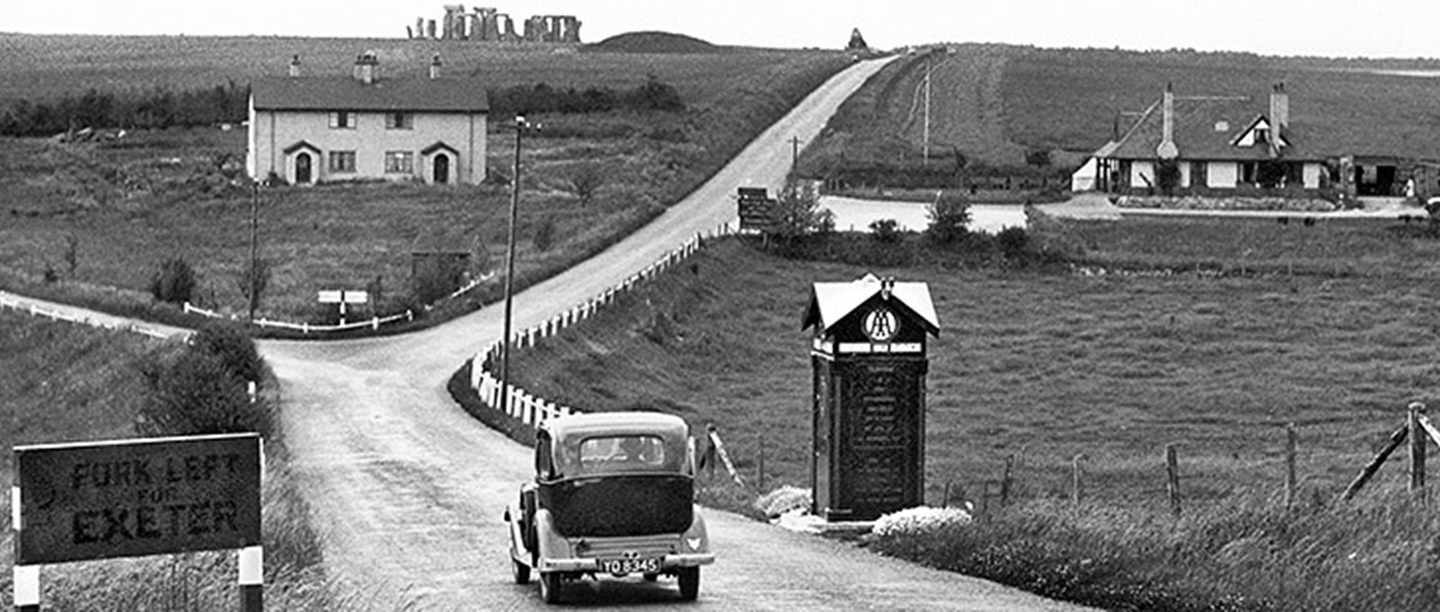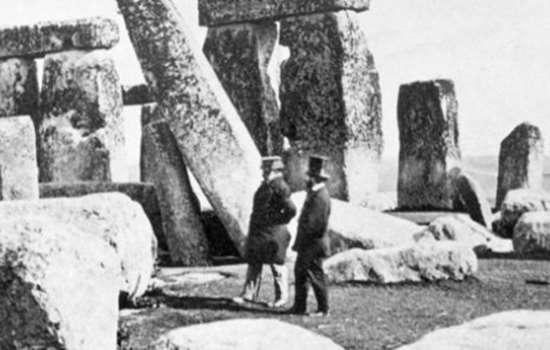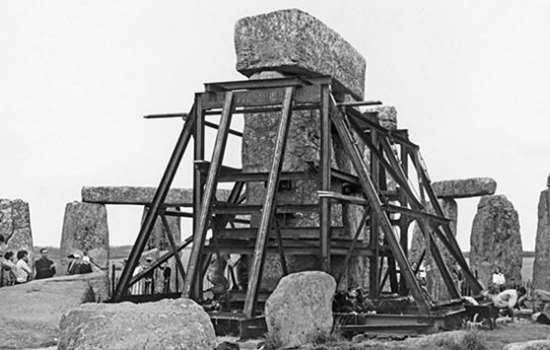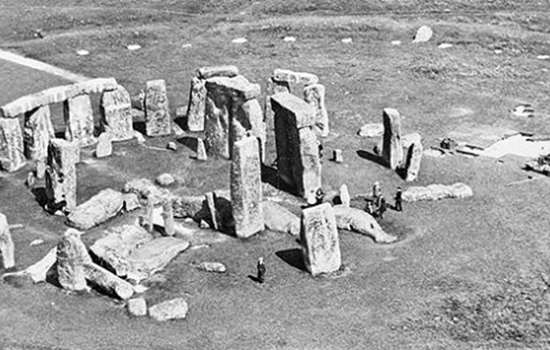
It’s 100 years since Cecil and Mary Chubb gave Stonehenge to the nation, and we’re marking the anniversary with a series of blog posts tracing the care and conservation of Stonehenge since 1918. Here, we look at how the Stonehenge landscape changed in the 1930s and 1940s, and at how vastly increased visitor numbers overwhelmed the monument’s once meagre facilities
After William Hawley’s excavations finished in 1926, little further archaeological exploration took place at Stonehenge for nearly 30 years. But there was plenty of other activity in the surrounding landscape.
A blot on the landscape
Most of this activity centred around the setting of the monument and concerns about its future. The No. 1 School of Aerial Navigation and Bomb Dropping had been based at an airfield immediately beside Stonehenge since 1917. The aerodrome featured two camps either side of a take-off and landing ground, with the larger main camp lying either side of what is now the A303.
The airfield had closed in 1921 but its buildings were still standing – a blot on the Stonehenge landscape. The owner, Isaac Crook, should have demolished the buildings when the government handed the land back to him. Instead, he was running a pig farm and letting some of the former living quarters as ‘undesirable dwellings’, raising much local indignation. Demands for the eviction of Crook’s tenants were countered only by the Reverend H Moxon, vicar of Amesbury. He alone seems to have shown sympathy for these unfortunate people.
The public appeal
The situation was complicated by the launch in August 1927 of a public appeal to raise funds to buy the airfield site. They wanted to donate it to the National Trust and save the land from the threat of future development. This ‘threat’ seems to have been rather whipped-up out of nothing.
The appeal had a murky and complex history – several people later claimed that they had started it. However, one man, John Charles Williams, Lord Lieutenant of Cornwall, put his hand in his pocket and guaranteed the full sum – £5600 – should the public not stump up. Crook was willing to sell, but many people thought he would raise the price when he learned about the appeal.
In fact the sale went through before the appeal was launched. Most of the aerodrome buildings were demolished by 1930, although a few of the huts were still occupied for at least another two years.
But the appeal aimed to buy much more than just the former airfield. Though money was slow to come in, its goal was eventually realised. Much of the land around Stonehenge now belongs to the National Trust.
A terrible idea
Meanwhile, at Stonehenge itself, the idea of digging a sunken fence to protect the monument was resurrected. A ‘ha-ha’ (or sunken boundary) had first been mooted in about 1900, but instead a simple post-and-wire fence had been erected around the site. The idea now was to enclose the whole ‘Stonehenge Triangle’ – the area bounded by the modern A303, the old A344 and the byway to the west. Only the caretakers’ cottages at the junction of the A303 and A344 would be excluded.
The design envisaged not only a massive ditch but also within it a fence with iron spikes and strands of barbed wire. Fortunately the scheme was quietly abandoned, probably for lack of finance, though perhaps someone in authority realised what a terrible idea it was.
Threats to the landscape
In the late 1930s concern mounted about damage to the prehistoric barrows and other monuments around Stonehenge. In 1935 local archaeologist Robert Newall expressed his worry about the destructive tendencies of both rabbits and the National Trust. The rabbits were digging into barrows; the National Trust were diverting tracks and planting trees.
In the following years the Greater Cursus and barrows of the Cursus Group were put under the plough. A new pig farm that was damaging the western end of the Cursus caused some protest, though another pig farm on the Wilsford Barrow Group apparently attracted little notice from the archaeological community.
With the coming of war in 1939 the dangers only increased. Australian soldiers had to be prevented from digging holes in the Cursus Barrows. It was also suggested that the ‘Stonehenge Triangle’ itself should be put under the plough as part of the war effort. The Chief Inspector of Ancient Monuments put up a robust defence (albeit based on rather questionable arguments) and the Wiltshire War Agriculture Committee was only too happy to drop the idea.
Coping with visitors
Visitor numbers had increased in the early 1930s, with more than 15,000 visitors recorded arriving at Stonehenge in one midsummer month in this period. This was largely the result of a huge upsurge in car ownership, enabling families to set out and explore the British countryside for themselves. Stonehenge even featured on advertisements for Shell petrol at this time.
The single custodian was often overwhelmed. By 1935 a small car park was leased on the opposite side of the Shrewton road to prevent cars from blocking traffic. The Stonehenge visitor experience at this time was enhanced by a site museum, housed in one of Hawley’s excavation huts. But this wasn’t a permanent solution, and within a few years the hut was leaking so badly that the finds had to be transferred to Salisbury Museum.
A further amenity was the Stonehenge Café, established in 1927 on the edge of Stonehenge Bottom, just over 360 metres from the stones. The café was described in an Office of Works memo as ‘a cheap flashy little building’ which ‘vulgarises unspeakably this world famous and most impressive monument’. Such objections ensured its demolition in 1938, despite its acknowledged value for visitors. The custodians’ cottages were demolished at about the same time.
With the coming of the 1950s, attention turned back to serious archaeological research at Stonehenge.
Find out more
You can read more on our website about the history of Stonehenge and the Stonehenge WWI aerodrome, and download the research report Stonehenge Aerodrome and the Stonehenge Landscape from Historic England.
Top image: This view of Stonehenge in the 1930s, taken to emphasise ‘undesirable’ modern intrusions in the landscape, now appears full of period charm. The custodians’ cottages are in the centre, and the Stonehenge Café to the right. © Historic England Archive


